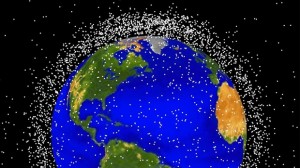March 12, 2014 – One of the growing problems of our venture into near-Earth space is garbage. We humans are great at discarding stuff whether here on Earth or in our neighbouring space. The total space junk from low-Earth orbit to geostationary locations amounts to somewhere between 300,000 and 500,000 pieces from defunct satellites to lost items from human extra-vehicular activities (see the NASA image below). There are rocket parts, bolts and screws, old satellites, cameras, tool kits, you name it, all flying around the planet at speeds of plus 28,000 kilometers (17,500 miles) per hour. And some of this garbage is colliding with other garbage increasing the hazard.
For the International Space Station, which has had to execute collision avoidance manoeuvres several times, and for new satellites we launch, and for the soon to be space tourism industry it makes sense that we clean up the mess we have created. Imagine one collision with a future space hotel and the consequences of such a disaster.
That’s why Australia in partnership with NASA, Japan, Lockheed Martin and others is dedicated $20 million to develop a laser tracking system to find this space junk with the ultimate goal to use these lasers to zap the stuff and make it fall out of orbit to burn up in the upper atmosphere.
Australia’s EOS Space Systems currently tracks about 10% of the known garbage in space. On the company’s website it states that “over the next decade over $400 billion of capital investment projects are at risk at some level from space debris.” That would seem more than enough justification to spend $20 million to begin addressing the problem. With the new investment EOS hopes to find and track up to 50% of the debris in near-Earth orbit within the next five years. The company is also researching cost-effective debris avoidance technologies that may be deployed in space at some time in the future.
What’s involved in zapping space garbage? A laser exerting about the same pressure as the solar wind for five to ten minutes could do the trick changing that piece of junk’s position in space by as much as 100 meters (330 feet) and therefore sending it on a descent into the atmosphere.












[…] https://www.21stcentech.com/space-update-australia-takes-lead-cleaning-space-junk/ […]
[…] Australia Takes Lead in Cleaning Up Space Junk https://www.21stcentech.com/space-update-australia-takes-lead.….pace-junk/ […]